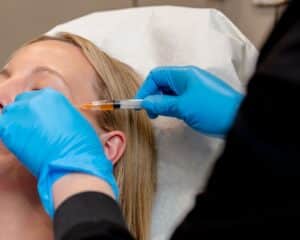Platelet-rich fibrin (PRF) is a natural, regenerative treatment that has become increasingly popular in the past few years. It has been used in various medical fields, including oral and maxillofacial surgery, orthopedics, and dermatology. PRF is a concentrate of platelets and growth factors that are derived from the patient’s own blood.
What is PRF?
PRF is a fibrin matrix that is derived from the patient’s own blood. The process involves drawing a small amount of blood from the patient and then centrifuging it to separate the platelets and growth factors from the rest of the blood components. The resulting PRF is a sticky, yellowish substance that is rich in growth factors, cytokines, and other healing proteins.
How does PRF work?
PRF works by releasing growth factors that promote healing, reduce inflammation, and stimulate the regeneration of tissues. The growth factors in PRF include platelet-derived growth factor (PDGF), transforming growth factor-beta (TGF-β), and vascular endothelial growth factor (VEGF), among others. These growth factors work together to enhance tissue regeneration, increase blood supply, and promote the formation of new collagen.
What are the benefits of PRF?
PRF has several benefits, including:
1. Faster healing: PRF accelerates the healing process by promoting tissue regeneration and reducing inflammation.
2. Reduced risk of infection: PRF is derived from the patient’s own blood, which means there is no risk of rejection or infection.
3. Minimal scarring: PRF promotes the formation of new collagen, which can help reduce scarring and improve the overall appearance of the skin.
4. Long-lasting results: PRF can provide long-lasting results, as the growth factors in PRF stimulate the regeneration of tissues, resulting in natural-looking, long-lasting results.
What are the common uses of PRF?
PRF has several applications, including uses in facial rejuvenation. PRF can be injected into the skin to promote collagen production, reduce fine lines and wrinkles, and improve overall skin texture. Sometimes this is referred to as a “biostimulator.” We often use it in conjunction with microneedling, microneedling with RF, and vampire facials. It has been shown in studies to increase hair growth when used in conjunction with mirconeedling on the scalp when done in 4 treatments spaced one month apart. When used during a treatment or immediately after, it helps promote wound healing and decreases incidence of infection.
Dentists, oral surgeons, and orthopedic surgeons also use PRF for wound healing and promotion of growth factors.
You may have also heard of PRP or platelet-rich plasma being used in similar applications. So what is the difference? Well, both are autologous blood products that are used in rejenerative medicine. However, the differ in preparation and application. PRP is prepared using a fast centrifuge to separate out the platelets. PRF, on the other hand, is prepared by using a slower centrifugation process that preserves more of the white blood cells and fibrin, resulting in a thicker and more stable clot. Because of the more gentle preparation, the result is release of growth factors for 7 days or more vs rapid degranulation and a spike in growth factor activity over just a few hours with PRP preparations. Also, the matrix can be use with more specificity where applied vs a general diffusion into the tissue with the thinner PRP. The calcium chloride that is used to neutralize the sodium citrate will not have the characteristic “burning or stinging” typical with PRP application.
Call us or book online to schedule a consultation to discuss PRF.

